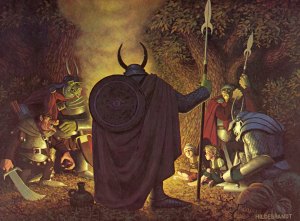
AP Prophetic Lit (CaD Dan 11) – Wayfarer
“His armed forces will rise up to desecrate the temple fortress and will abolish the daily sacrifice. Then they will set up the abomination that causes desolation. With flattery he will corrupt those who have violated the covenant, but the people who know their God will firmly resist him.”
Daniel 11:31-32 (NIV)
Throughout my school years, I had various teachers and counselors encourage me to take Advanced Placement (AP) courses. In many cases, like English and History, I was ready for the challenge and it worked out really well in accelerating my studies in those subjects. In other cases, namely math, I wasn’t ready to make the jump that my teacher insisted I take. I never really recovered. Eventually, I ended up abandoning math as a course of study. I have always regretted this.
In a similar way, I know many who at some point in life, perhaps multiple times, dive in and commit themselves to read the Bible. Since most books contain a linear storyline, it’s common to start at the beginning. But the Great Story, while it does have a storyline, is arranged thematically. Some parts read fairly easily for modern beginners, even if the ancient stories contain head-scratching content. At some point, however, most casual readers give up and abandon it like I abandoned the subject of math. I consider this regrettable.
The truth is that some sections of the Great Story are difficult even for learned readers. Among the most difficult are prophetic, or apocalyptic, passages like today’s chapter. Daniel’s complex and detailed vision is actually quite fascinating, but without a little background knowledge of both history and apocalyptic theories, it could easily seem like a hodgepodge of gobbledygook.
What’s fascinating is that most of today’s chapter is a very accurate prophecy regarding the fate of the land of Israel in the centuries following Daniel. The prophetic vision is like a playbill identifying all of the key players in the historic dramas of the Persian and Greek Empires. It leads to one of the most infamous periods of their history, a period most modern followers of Jesus know little-to-nothing about because it happens between the Old and New Testaments.
A few chapters ago I briefly mentioned the heinous ruler arose to power in the land of Judea before the ascendence of the Roman Empire known to history as Antiochus Epiphanes. He sought to eradicate Judaism in Judea. To that end, he famously shut down Jewish worship at the rebuilt temple in Jerusalem and then audaciously sacrificed a hog on the altar in a pagan ritual to Zeus. Hogs were considered unclean by the Law of Moses, and his act was seen as a blasphemous abomination prophetically predicted by Daniel in verse 31 of today’s chapter. As I contemplated this in the quiet this morning, I thought about how I might feel if a Satanic ritual abortion was performed on the altar of my local church.
So far so good, but starting in verses 35-36, the prophetic narrative stops clearly describing actual historic events and rulers. The final section of the chapter has yet to be fulfilled historically in any meaningful way and it remained somewhat mysterious for over 500 years. Then Jesus spoke to His followers about the end times and mentions that there will be another “abomination that causes desolation” (Matt 24:15). History does have a way of repeating itself, and Jesus seems to indicate that there will be another version of Antiochus Epiphanes to come. A few decades later, John received his Revelations on the Isle of Patmos and his visions of an antichrist and an unholy trinity of the dragon (Satan) and two beasts (anti-christ and his prophet). The end of today’s chapter seems to fit hand-in-glove with John’s vision of a blasphemous, conquering anti-christ sweeping in to conquer the Holy Land. And so, scholars contend that the final prophetic writings of Daniel have yet to be fulfilled. They are pieces of a prophetic puzzle regarding the end times.
So what am I supposed to take away from today’s AP Prophetic Literature chapter? What does it have to do with me this Wednesday morning in the 21st century?
The first thing is very simple. Daniel’s prophetic vision so accurately predicts the geo-political events of the next couple of hundred years that I’m reminded of what many artists have found to be true: things are already written. And, this leads to the second thing.
When Paul writes that “all things work together for good for those who love God and have been called according to His purpose” (Rom 8:28) it is more true than I can possibly imagine. This sows seeds of peace in my soul, no matter the outward circumstances. I think of a scene in The Lord of the Rings in which Galadriel explains to Frodo that the completion of his mission will mean an end to the power of the three elven rings and an end to the elves time in Middle Earth. When Frodo asks Galadriel what she wishes to happen, she replies, “That what should be shall be.”
Having the desire that “what should be, shall be” on the grand scale of the Great Story affords me much-needed context to the rather minor scale of my own life circumstances.

If you know anyone who might be encouraged by today’s post, please share.













